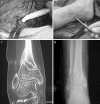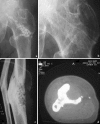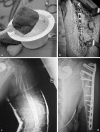Bone substitutes in orthopaedic surgery: from basic science to clinical practice
- PMID: 24865980
- PMCID: PMC4169585
- DOI: 10.1007/s10856-014-5240-2
Bone substitutes in orthopaedic surgery: from basic science to clinical practice
Abstract
Bone substitutes are being increasingly used in surgery as over two millions bone grafting procedures are performed worldwide per year. Autografts still represent the gold standard for bone substitution, though the morbidity and the inherent limited availability are the main limitations. Allografts, i.e. banked bone, are osteoconductive and weakly osteoinductive, though there are still concerns about the residual infective risks, costs and donor availability issues. As an alternative, xenograft substitutes are cheap, but their use provided contrasting results, so far. Ceramic-based synthetic bone substitutes are alternatively based on hydroxyapatite (HA) and tricalcium phosphates, and are widely used in the clinical practice. Indeed, despite being completely resorbable and weaker than cortical bone, they have exhaustively proved to be effective. Biomimetic HAs are the evolution of traditional HA and contains ions (carbonates, Si, Sr, Fl, Mg) that mimic natural HA (biomimetic HA). Injectable cements represent another evolution, enabling mininvasive techniques. Bone morphogenetic proteins (namely BMP2 and 7) are the only bone inducing growth factors approved for human use in spine surgery and for the treatment of tibial nonunion. Demineralized bone matrix and platelet rich plasma did not prove to be effective and their use as bone substitutes remains controversial. Experimental cell-based approaches are considered the best suitable emerging strategies in several regenerative medicine application, including bone regeneration. In some cases, cells have been used as bioactive vehicles delivering osteoinductive genes locally to achieve bone regeneration. In particular, mesenchymal stem cells have been widely exploited for this purpose, being multipotent cells capable of efficient osteogenic potential. Here we intend to review and update the alternative available techniques used for bone fusion, along with some hints on the advancements achieved through the experimental research in this field.
Figures








References
-
- Bhatt RA, Rozental TD. Bone graft substitutes. Hand Clin. 2012;28(4):457–468. - PubMed
-
- Greenwald AS, Boden SD, Goldberg VM, Khan Y, Laurencin CT, Rosier RN. Bone-graft substitutes: facts, fictions and applications. J Bone Joint Surg Am. 2001;83:98–103. - PubMed
-
- Finkemeier CG. Bone-grafting and bone-graft substitutes. J Bone Joint Surg Am. 2002;84(3):454–464. - PubMed
-
- Van Heest A, Swiontkowsi M. Bone-graft substitutes. Lancet. 1999;353(Suppl 1):S28–S29. - PubMed
-
- Faour O, Dimitriou R, Cousins CA, Giannoudis PV. The use of bone graft substitutes in large cancellous voids: any specific needs? Injury. 2011;42(Suppl 2):S87–S90. - PubMed
Publication types
MeSH terms
Substances
LinkOut - more resources
Full Text Sources
Other Literature Sources
Medical
Research Materials

